The best AV receivers and processors for 2024 have been compiled using the knowledge and resources of our reviewers at Home Theater Forum. Luckily, even in this cash-strapped age, there’s an option here to suit every budget. While supply chains over the past few years have hampered manufacturers’ release dates and delivery schedules, more products are starting to find their way into stores and online shopping warehouses. We are also starting to see interesting tech developments where manufacturers are incorporating more sophisticated in-room calibration systems and other features into their AV receivers. As time goes on, that means better performance per dollar spent for all of us.
As ever, although we have not had a chance to review every product that makes these lists, we always research what’s hot and what’s been getting the best reviews. Several of us on the team at HTF also get a chance to hear and see how these products perform at trade shows and industry events. We know some of you will have your own opinions about which devices deserve to be on this list, but keep in mind that our overview here is a composite of what we see in the wider world. There are a lot of good products out there.
Here is our selection of ten AV receivers and processors in ascending order of price and category that should accommodate most people’s tastes and affordability expectations. We certainly think you should check these out before handing over the plastic.
Table of Contents
Best Budget AV Receivers
Sony STR-DH790 Home Theater AV Receiver
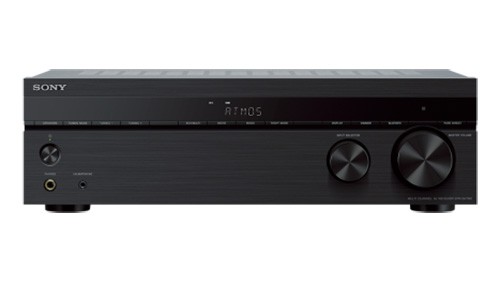
If you’re on a budget, the Sony STR-DH790 is the way to go! Sony continues to receive accolades for its recent groundbreaking HT-A9 home-theater-in-a-box and all-in-one multi-channel systems. The company also supports a legacy of producing professional audio codecs and products for theatrical applications. So, it’s reasonable to deduce that this most famed of Japanese brands is well qualified when it comes to movie sound. Seven-channel playback capability means you can achieve immersive audio in a 5.1.2 configuration.
Sony’s D.C.A.C. auto calibration tech has some nice features, including phase matching, which aligns the characteristics of all speakers to the left and right channels for more cohesive surround sound. Like the HT-A9, the STR-DH790 can reposition phantom speakers within your setup. This obviously alleviates speaker placement constrictions. The Sony delivers robust surround audio with good placement of effects within the soundstage. However, note that there are no analog video connections, ethernet or network support, or second zone capabilities.
Denon AVR-X1800H 7.2 Channel Receiver
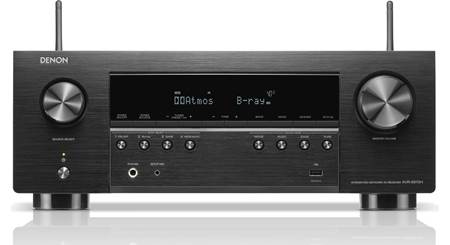
Denon is still the industry leader when it comes to both affordable and mid-price receivers. The company’s products usually find a few well-earned places on our lists, simply due to the breadth of products on offer. 2023’s AVR-X1800H was every bit as feature-driven as its worthy predecessors and came with a few surprises, too.
Sporting a myriad of HDMI connections, three ports of the available six accommodate the latest 8K/60Hz and 4K/120Hz capacities. These are a godsend to gamers, along with auto low latency mode (ALLM) and variable refresh rates, all neatly packaged into one of Denon’s stylish black front fascia profiles. The X1800H also amply compensates movie lovers with 5.1.2 Dolby Atmos and DTS:X immersive codecs.
If you don’t have Dolby upfirers or in-ceiling speakers to satisfy your craving for skyward sound effects, there’s DTS Virtual:X and Dolby Atmos Height Virtualization onboard to compensate. With Denon’s standard raft of music streaming features, such as Spotify, Tidal, and Apple AirPlay2, the receiver comes fully loaded. But remember, you get what you pay for. While the shopping list of features is commendable and we praise its detailed soundstage, note that musical performance can be a little mechanical and its movie chops sometimes lack the dimension of more expensive receivers.
Onkyo TX-NR6100 7.2-Channel THX Certified AV Receiver
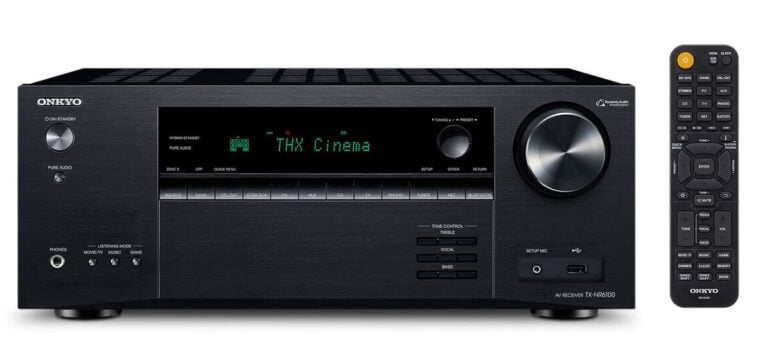
Onkyo, along with its sister brands Integra, Pioneer, and Pioneer Elite, has been through a few tumultuous years with bankruptcies and ownership changes. You could be forgiven for thinking the Onkyo brand had fallen off the map completely. So it’s reassuring to see that 2023’s crop of receivers from the Japanese manufacturer – and distributed by Premium Audio Company – are every bit as good as their forebears.
The TX-NR6100 decodes 7.2 channels of immersive audio to max out an impressive-sounding 5.2.2 setup. As well as a vast array of useful features, the receiver sports THX Certified Select status, meaning it can amply fill a small-to-midsize room with reference level movie audio. As well as three HDMI 2.1 inputs, there’s an excellent user interface with both app control and a Web UI setup option. Avid streamers also get to go to town with Amazon Music, Chromecast, Deezer, DTS Play-Fi, Roon, Spotify, and TIDAL platforms. If that wasn’t enough, there’s support for Alexa, OK Google, Bluetooth aptX HD, and Hi-Res Audio.
While the sound output is bold, dynamic, and satisfying, the effects steering skills might not quite match up to that found in pricier receivers. AccuEQ room correction is also a little basic. But you get a lot for the money here, so the TX-NR6100 earns a rightful place in our budget category AVR list.
Keep an eye out for a dropping price, too. It seems several retailers in the US have recently slashed the $799 list by a fair chunk.
Best Mid-Priced AV Receivers
Marantz Cinema 60 7.2 Channel AV Receiver
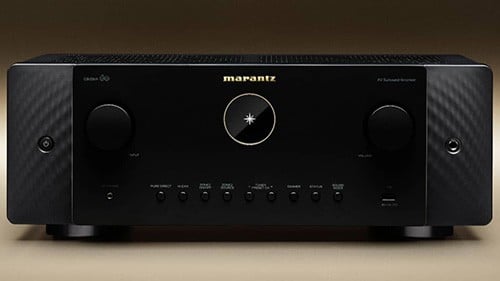
When medical devices company Masimo paid $1 billion for Marantz’s parent company Sound United in 2022, many wondered what the upshot would be for budding AV-philes. But one thing’s for sure, there was a significant cosmetic overhaul of Marantz’s AV processor and receiver lines.
The Cinema 60 7.2-channel AV receiver replaced the former SR5015 but incorporated a striking new look. The company ditched the former curved-side front fascia design, which was frankly starting to look a bit tired. Marantz’s new Cinema line receivers sound much like their predecessors and are as feature-rich as ever. Although the AVR falls short on providing the Dirac Live room correction platform (for that you’ll need to upgrade to the pricier Cinema 50 model), you do get to optimize your listening space with Audyssey’s competent MultiEQ XT platform.
This versatile AV receiver arrives with 100 watts per channel (8 ohms, two channels driven), three HDMI 2.1 inputs, HEOS compatibility, and hi-res music playback. The Cinema 60 can support a 5.2.2 Dolby Atmos setup or you can opt for a 7.2 ear height layout. (If you want four separate subwoofer outputs, that will also involve the near $500 hike to purchase the Cinema 50 AVR.)
Considered ample for a mid-sized room, the Cinema 60 can produce all the power required for your movies with accurate effects placement and a sense of realism. Two-channel music listening is also surprisingly proficient, so give it a listen if you live close to a dealer and the price tag fits your budget.
Denon AVR-X4800H AV Receiver
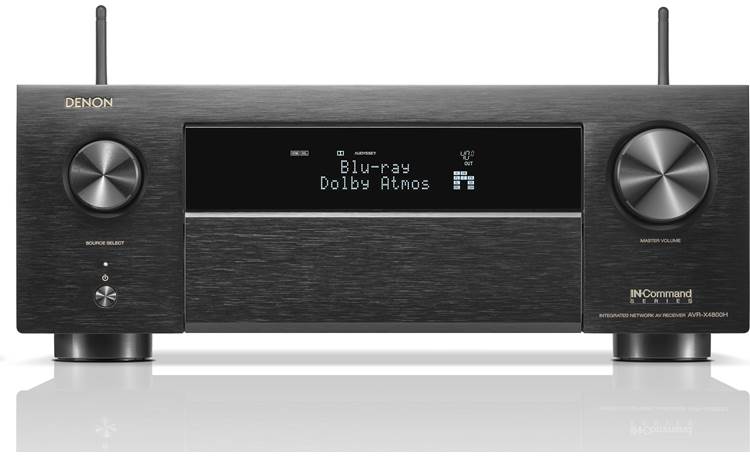
Denon’s 9.4-channel AVR-X4800H comes in with a predictably more rounded-out roster of features than the entry-level AVR-X1800H (see above). With nine amplifier channels onboard, you can choose to set up seven ear-level and two ceiling channels in a 7.1.2 configuration or push out your Dolby Atmos array to include four ceiling channels in a 5.1.4 layout. If you decide to upgrade your system to use discrete power amplifiers, Denon wisely includes 11 pre-outs. These complement four subwoofer RCA pre-outs if you decide to have one in each corner of the room.
The claimed power output is 9 x 125 watts, and there are eight HDMI ins and three outs, plus a three-zone multi-room capability, care of HEOS. There is also IMAX Enhanced certification for those with a leaning towards the audiovisual prowess of the marque. Immersive audio formats include Dolby Atmos, DTS:X, and Auro-3D. Denon prides itself in delivering a host of voice assistant compatibilities on its platform along with music streaming services from Amazon Music HD, Spotify, TuneIn, and TIDAL.
Audyssey’s MultiEQ XT32 in-room calibration promotes an easy walk-through for beginners and the results from multiple seats achieve an excellent sonic response. The option to pay for Dirac Live with Bass Control will be a delight for many die-hard AV tweakers wanting optimal low-frequency performance. The AVR-4800H scores big on both clarity and unapologetic slam during action movie playback, as well as offering an engaging music listen.
Take a look at where our reviewers also universally praised the AVR-4700H for both clarity and unapologetic slam during action movie playback, as well as its dynamic music chops.
Yamaha RX-A6A 9.2 Channel Aventage Receiver
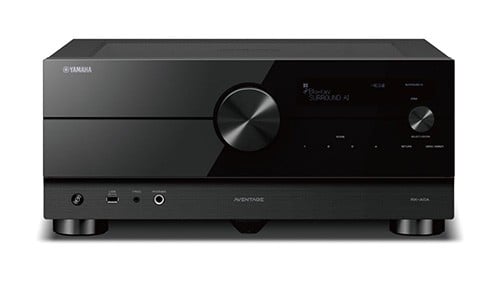
Many of you will want to protect yourselves from future redundancy by upping the channel count, and the Yamaha RX-A6A arrives with just that solution. A ‘full’ Dolby Atmos-friendly setup consists of a 7.1.4 configuration. While the Yamaha processes 11 channels, it only amplifies nine onboard. This means you can purchase a separate two-channel power amp to add to your system for either the front left and right, or rear height speakers.
The RX-A6A also adds Auro-3D to its portfolio of immersive audio codecs, Dolby Atmos and DTS:X. There’s a good sprinkling of HDMI connectivity, voice control, and streaming options, plus a DAB+ radio thrown in. While Yamaha’s YPAO calibration system doesn’t quite muster the tweakability and performance of its nearest competitors like Dirac, it does get points for easy usability.
With all that in mind, the RX-A6A delivers on the brand’s undisputed music legacy with naturalism and delicacy applied to disc and streamed sources. Movie playback is both heavyweight and authoritative, so, if this box is within your budget, add it to your audition list.
Best Mid-High Priced AV Receivers
Anthem MRX 740 8K 11.2 Preamplifier/Receiver
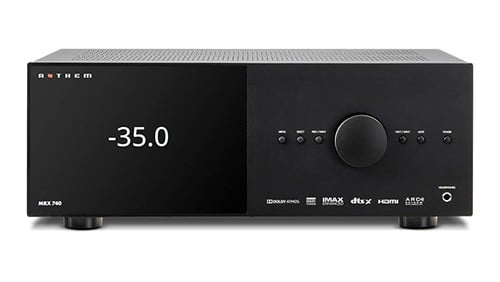
While the Anthem MRX 1140 has 15.2 channels of processing, its more budget sibling, the MRX 740 8K, sports 11.2 channels with seven channels of onboard amplification. The Anthem range has undergone a spectacular overhaul of its design aesthetic, now resulting in a much more 21st-century profile and appeal. The MRX 740, with its lefthand top to bottom edge display screen, resembles something much closer to the clean lines of the Lyngdorf processor line.
Power output measures 170 watts x 5 (all channels driven) and two 75 watt channels, all into 6 ohms (or 140 watts and 60 watts into 8 ohms). Anthem Room Correction (ARC), the company’s in-house calibration system, can produce spectacular results and is still the tech to beat in this price category. ARC allows for the saving of multiple profiles for different rooms, and you can also create your own custom target curves. The Anthem accommodates Dolby Atmos and DTS:X object-based audio and is IMAX Enhanced certified.
Many consider the most recent crop of Anthem receivers and preamplifiers to be some of the best on the market with their soaring performance on movies and precision and articulacy on music sources. The sub-$3k price tag translates into true bargain territory when measured up against the MRX 740’s excellent slew of features and barnstorming performance.
Arcam AVR31 HDMI 2.1 Class G AV Receiver
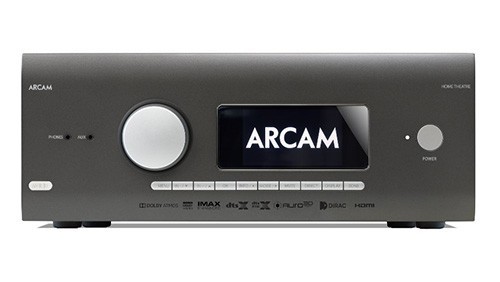
If you feel you are ready to take that step up to a 16-channel processor/receiver and don’t want to budget for the $10k-plus region, Arcam is a good place to fix your gaze. The AVR31 can decode Dolby Atmos, DTS:X, and Auro-3D. There are seven channels of Class G amplification, which Arcam bases on the innards of the company’s stereo amplifiers.
Dirac Live room optimization is the onboard calibration process, but you can tweak performance with the optional Dirac Live Bass Control as well. With seven HDMI 2.1 inputs and three outputs, all the former of which support 8K at 60 Hz and 4K at 120 Hz, and a host of streaming options, the AVR31 is more than future-proof. The dark gray chassis and overall build quality reflect the class of product in which it resides. There is also a full-color matrix showing album artwork on the front display when you cast your tunes.
But the value proposition here is in the audio reproduction. The AVR31 can discern the quietest and most subtle movie soundtrack cues with exquisite sound field placement and unleash tremendous dynamics when required. Such a level of performance should put this AV receiver at the top of any serious home theater aficionado’s consideration list.
Best High-End AV Processors
Lyngdorf MP-60 Surround Sound Processor
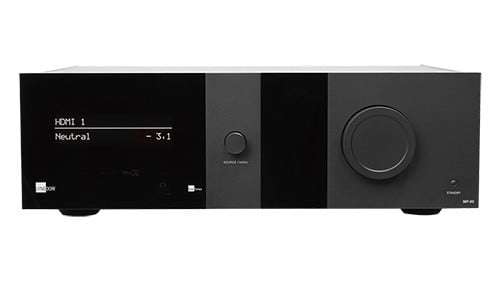
Danish maestros Lyngdorf know a thing or two about HiFi, so much so that piano makers Steinway decided to enter into a joint venture with the brand to produce higher-than-high-end audio components and loudspeakers. But with Steinway-branded price tags that could make the eyes water, head honcho Peter Lyngdorf wisely decided to make the magic available to mere mortals by disseminating some of the core technologies to the Lyngdorf brand itself.
The company’s first home theater processor, the MP-50, hit the market in 2017. Although it could decode 12 discrete channels (with a matrix facility out to 16), it arrived just before the HDMI 2.1 specification took hold. Consequently, you could only max out video switching and pass-through with 4K HDR sources at 24 frames per second. We’ve also reviewed the MP-40 here.
While that’s more than enough for most people, the new MP-60 arrived with the fully-leaded HDMI spec and 16 discrete channels of decoding. Lyngdorf designs its kit with a beautiful low-key Scandinavian aesthetic and the MP-60 is capable of an exquisite sound. Both immersive-audio movie and two-channel music sources are so warm and realistic as to be tangible. The brand has an intensely loyal following and you will find it a formidable challenge to wrench devotees from the cause.
Trinnov Altitude16 Surround Sound Processor
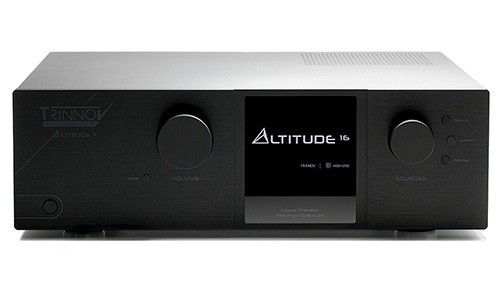
Back in 2021, Trinnov announced that it would release a 16-channel processor to add to its already legendary Altitude processor line. Its forebear was named Altitude32 because, yes, it could decode up to 32 channels (and more) of immersive audio. Realizing that most customers would probably find that many speakers in their living room overkill, they introduced the Altitude16. But the Trinnov preamp/processors are still considered the high bar in home theater performance with their extraordinary ability to place sounds with devastating accuracy and render house-demolishing dynamics throughout the listening area.
The Altitude16 harbors a fully upgradeable platform and is designed to sit in your home theater rack for years. Based on a PC architecture, Trinnov developed its own immersive audio chips in-house (and not sourced off the shelf) by talking directly to Dolby and DTS. The results are awe-inspiring, even if competitor Lyngdorf arguably holds the prize for best music performance from its home theater preamps. The latest processor updates include Waveforming technology, which enables high-impact and smooth bass coverage in equal measure for every seat in an auditorium.
Trinnov throws in Auro-3D and IMAX Enhanced certification over and above the Dolby Atmos and DTS:X Pro codecs. You also get Trinnov’s second-to-none Room Optimizer, a visual interface to let you monitor the travel of object-based effects as they glide around your room, and a remapping tool to correct for less-than-perfect speaker placements. The Altitude16 is one box to drool over and dream about.
What to Look For When Getting the Best AV Receivers and Processors
Whether it’s for an immersive surround sound experience or an upgrade, the decision about which AV receiver to get can be overwhelming due to the plethora of options and technical details. However, we’re here to streamline your buying process, regardless of your expertise level.
We’re in an era of rapid technological advancements, with brands consistently introducing innovative features and improved in-room calibration systems in their receivers. This progress promises enhanced performance and value for money, ensuring there’s a suitable option for every budget. Yet those same advancements increase the amount of technical jargon we have to parse as consumers.
Before you make your purchase, it’s essential to understand some key considerations. We’re here to guide you through these aspects, ensuring you make an informed decision when selecting your ideal AV receiver.
Understanding AV Receivers and Processors
First, we need to get our heads around what makes the best AV receivers the best. Think of an AV receiver or audio/video receiver as the hub of your home theater system. You attach all your sources to an AV receiver, like a Blu-ray player, game console, and satellite receiver.
At the same time, the receiver sends video signals to your display(s), like a TV or projector. Because you can select each input and output on an AV receiver, the unit also becomes a switching device.
An AV receiver often decodes common surround sound formats, like Dolby Digital 5.1 or Dolby Atmos. So, if you have a lot of loudspeakers in your home theater, you can take advantage of the latest audio formats.
Receivers include onboard amplifiers for multi-channel audio. In other words, a receiver with a nine-channel count can provide power to nine different loudspeakers.
But this is where an AV receiver or surround sound amp differs from an AV processor. An AV or home theater processor (also known as a preamp or controller), has no amplifiers on board. It will do all the source switching and audio and video processing that a receiver can do, but an AV processor won’t be able to send an audio signal to your speakers. You will need separate power amplifiers for the job.
AV processors have advantages, although they are generally more expensive than AV receivers. Often the manufacturer puts more engineering resources into a processor, so you should end up with better audio and video performance. Processors also don’t have to house all the complex and heat-generating circuitry of receivers.
Key Factors to Consider When Buying AV Receivers or Processors
Now that we understand the basic differences between an AV receiver and a processor, we need to decide what we can live with and live without. This checklist will help with your final buying decision. Keep focused on our eight key factors to consider when homing in on your final purchase:
Price
Before you do anything, decide how much money you have to spend. It may sound obvious, but if you have a budget, stick to it. Remember that if you are just starting out, you might need a TV, loudspeakers, subwoofers, and source devices as well. The bill can spiral quickly, so don’t get caught out. Some of you might have $500 to spend on an AV receiver, others $5,000. It’s not a race to the top. Just know the limits of your own wallet!
Audio Quality
The more you spend, generally, the better audio chops you will get. But it’s not always the case.
If you can, listen to the equipment you are thinking of buying in demo rooms and stores. Always listen out for clear dialog, detail from music and sound effects, and great dynamics (the contrast between loud and soft moments).
Some AV receivers have high-quality DACs (digital to audio converters) which can make the sound more pleasing, detailed, and warmer in character. More powerful onboard amplifiers (measured in watts per channel) can support louder and cleaner audio, but make sure they are matched to your speakers’ power handling.
Video Quality
Most AV receivers and processors pass through video signals unchanged from the source. But you may decide that the upscaling function is better handled by a TV than by a receiver. For example, if you want to upscale a DVD to use all the pixels on a 4K display, you can select either device to make it happen.
Standard Blu-ray and 4K UHD players often have upscaling features as well, so there are a few places in the video chain where you can optimize performance. If you own or watch a lot of lower-resolution content and upscaled images are important to you, remember to do your research.
Connections
While most AV receivers have several HDMI, optical, and RCA inputs, make sure that the model you eventually purchase has what you need. If you have many sources, you don’t want to fall short. Some receivers, for example, scrimp on analog inputs but overdose on HDMI inputs. Most video sources use HDMI to carry hi-res images and sound to your receiver, but several manufacturers are dropping legacy connections to save costs.
Also, check for network capabilities and Bluetooth. Many AV receivers and processors have multiple music streaming options, too, although you need to be sure that your subscriptions are covered. If vinyl is your thing, then also check that the receiver has a phono input if your turntable does not have a built-in preamp.
These days, most receivers include USB ports for music or other content. Sometimes firmware updates require a USB service port for ensuring the latest performance tweaks can be loaded onto the AV receiver’s motherboard.
AV processors usually have XLR-balanced connections to connect to power amplifiers. If your amplifiers only have RCA connections, then you will need XLR to RCA adaptor cables. Balanced XLR connections are usually the preferred option to reduce the noise floor of your system.
Number of Channels for AV Receivers
Again, this really comes down to your budget. Most people settle for 5.1 (three front channels, two surrounds, and one subwoofer). This is all you need for a basic surround sound layout. You can also be more adventurous and go for a 7.1 system.
But the new Dolby Atmos and DTS:X codecs allow for layouts with five or seven ear-level speakers, two or four height speakers, and a subwoofer channel. You might see these layouts referred to as 5.1.2 and 7.1.4.
A few mid-price and high-end AV receivers and processors now offer 16 channels. This means you can add more ear level and height channels to a setup. So, your layout could be 9.1.6, for example. The most expensive Trinnov processor enables 32 channels, but you will need a big room to justify installing a processor like that. Some high-end processors can make subwoofers channel-related, too, so they can redirect bass to specific room quadrants for more impact.
Room Correction
When you buy a new AV receiver or processor, it is important to run the included in-room correction software. The process is usually simple and involves following a step-by-step on-screen guide. A measuring microphone and stand are always included in the package.
There is no such thing as a room correction system. You should, however, try to get familiar with the features of the receiver you are considering. Room correction could be a factor in your decision-making process. So, do the research.
It is easier to set up a two-channel stereo system for normal listening. But multi-channel surround sound needs careful measurements of distance to the listening position(s) and sound pressure levels (SPL) from each speaker. If you are a bit more tech-savvy, you can use an analog or digital SPL meter to balance the levels yourself before running automated room correction.
If you don’t run room correction, the resulting sound can be muddy or confused. Some room correction systems now include nifty time and frequency domain adjustments. Others can measure the specific performance of the type of speaker in your specific room.
Well-known room correction systems include those from Audyssey, Dirac, and RoomPerfect. Each has its own method for achieving great sound in your room. But always follow the instructions for running the software. It sounds scary, but it isn’t. And you will be grateful for spending the time to learn how to do it.
Ease of Setup and Use
The best AV receivers from the likes of companies like Denon, Marantz, Pioneer, and Yamaha have very easy setup procedures and manuals. If you choose to go up the price ladder to products by, say, Lyngdorf, StormAudio, or Trinnov, the learning curve might be a little steeper. High-end processors and receivers are often designed with professional installers in mind, so they will have more features and functions that can be customized.
Brand Reputation and Customer Service
Most manufacturers these days offer comprehensive repair and return warranty programs. Every so often, a product will experience a problem during a warranty period, but thankfully it’s rare. If it happens after that time, you will probably have to pay for your own repair. There is always an upside to buying from a reputable dealer or retailer, though. Some retailers or installers have terms that improve upon those offered by the manufacturer.
A few of the well-known brands have excellent phone support lines if you run into difficulties during setup. Other brands even have trade-in services if you decide to upgrade from one receiver to another further down the road.
Decoding AV Receiver Technical Specifications
There are some terms you may commonly see listed in AV receiver specs. But always take them with a small spoon of salt. In the end, your ears will be the best judge of what sounds good. We highlight perhaps the three most common ones which are often in the small print but good to be aware of when comparing prospects:
Watts Per Channel
You will see the power output ratings measured as ‘watts per channel.’ Yes, an amplifier will be louder if it has more wattage. But you will have to double the power to increase the sound level by just 3 dB.
In other words, you do not need to worry too much about the watts per channel figure. For a great dynamic home cinema, 100 watts per channel is more than ample and you can get away with a lot less than that to achieve professional cinema-type volume levels in a small room.
With that said, manufacturers often quote amplifier power as a peak value, which can sound grand, but the one you should be interested in is RMS or the ‘root mean square’ value. The RMS power output is the average output that you should use to make sure your speakers pair well with amplifiers.
Manufacturers also talk about a power output when only one or two channels are driven. Again, this is usually a more impactful number than the power output when all channels are driven (i.e., when listening to multi-channel content). But the number will help you weigh up performance against other AV receiver models.
Total Harmonic Distortion (THD)
You will also see a figure of less than 1% to represent total harmonic distortion or THD. A quoted figure for THD might be 0.07%, for example. The value shows how much distortion of a voltage is due to harmonics in a signal, and is another good measuring stick when comparing products.
Impedance
Amplifiers are rated at the best speaker impedance they are designed to feed. It is usually measured as 4, 6, or 8 ohms. A 4-ohm loudspeaker load has less resistance, so an amplifier has to work harder to drive it. But the key here is to pair your amplifiers as close as possible to the measured impedance of your loudspeakers.
Top AV Receiver and Processor Brands in the Market
We have already talked about some of the well-known brands of receivers. Of course, Denon and Marantz are almost household names. Certainly, anyone who has researched buying an AV receiver will have come across them.
Both brands have gone through several ownership changes but they still prevail. Their products achieve amazing performance per dollar spent.
The same goes, perhaps to a lesser degree, for Pioneer, which disappeared entirely for a while. Last year, the Onkyo, Integra, and Pioneer brands were snapped up by Asian holding group Premium Audio Company. Integra is still a brand known for excellent mid-high-end receivers and processors.
Integra used to represent the installation-grade products of the Onkyo brand. And products from the latter company are starting to appear again after a long hiatus.
With its studied musical prowess, Yamaha is still in the game with a superb line of AV receivers.
Here in the US, Emotiva manufactures a line of AV receivers, preamps, and power amps from beginner level up to reference-grade integration products. There is something for everyone at direct-sale Emotiva, so check them out.
When you ascend the price ladder, other players like Anthem and Arcam populate the market with superb price/performance receivers.
Shunt up again to the luxury goods level and names like Lyngdorf, McIntosh, StormAudio, and Trinnov command the landscape. But seeing as most people don’t have $12k or so to drop on an AV processor, you will get less exposure to this class of product. With that said, we do look at a couple of these true high-end models in our top 10 list above.
Martin, a seasoned journalist and AV expert, has written for several notable print magazines. He’s served in key roles at Lucasfilm’s THX Division, NEC’s digital cinema division, and has even consulted for DreamWorks. Despite his illustrious career, Martin remains rooted in his passion for cinema and acting, with notable appearances in several Spielberg films, Doctor Who, and Star Wars: The Empire Strikes Back. He currently resides in San Francisco.
Post Disclaimer
Some of our content may contain marketing links, which means we will receive a commission for purchases made via those links. In our editorial content, these affiliate links appear automatically, and our editorial teams are not influenced by our affiliate partnerships. We work with several providers (currently Skimlinks and Amazon) to manage our affiliate relationships. You can find out more about their services by visiting their sites.

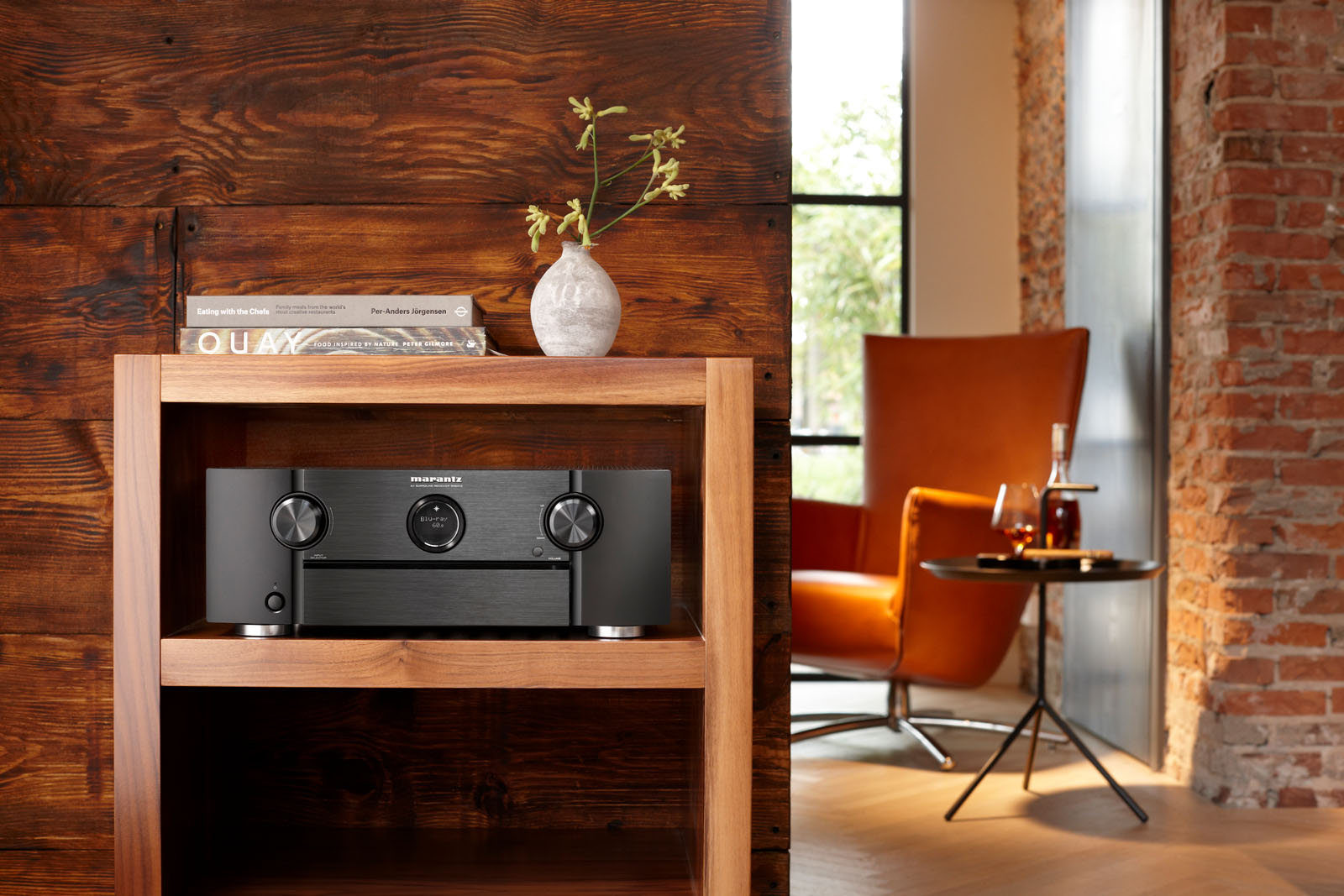

Similar threads